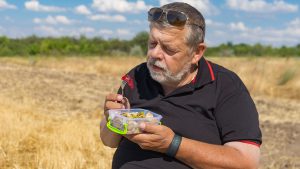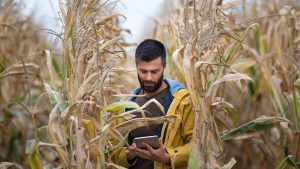Looking back
10 YEARS OF FINANCE

In recognition of Grain Farmers of Ontario’s 10th anniversary, Ontario Grain Farmer is talking to staff about the impact that the organization has made. This month we sat down with Tom Farfaras, chief financial officer at Grain Farmers of Ontario, to look back at initiatives over the past 10 years.
When the corn, soybean, and wheat legacy organizations merged into Grain Farmers of Ontario, what role did the finance department play?
Prior to the formation of Grain Farmers of Ontario, farmer-members, delegates, and directors from the legacy organizations along with government regulators, financial, and legal advisors engaged in facilitated meetings to develop the governance, organizational, financial, and regulatory model of our organization.
The outcome was that farmer-members received an information package that included pro-forma financial statements with an opening financial position, estimated annual expenses, and the corresponding check-off fee of $1.70 per acre that balanced the budget from the combined acreage of all three commodities. The assessed fee per tonne of each commodity was derived from the fee per acre using the average yield per acre.
Once the regulations came into force, many elements of the financial structure and limits were contained in regulations and the finance team worked to implement the financial model and adhere to the elements of the regulations, such as how much of a reserve we could maintain (just enough to cover one year expenses), and segregating the wheat marketing finances from the general operations.
The amalgamation provided the financial stability that farmer-members desired as the organization had financial resources to fulfill its mandate and carry out the strategic plan related to advocacy, communications, market development, and research, and support the grain marketing activity. The model was successful, and the appeal of this was evident with the addition of barley and oat commodities in 2015.
How have we maintained a strong financial footing?
There are many contributing factors to our strong financial position, such as governance and financial oversight of the Board of Directors, Finance and Audit Committee, annual financial audits, adherence to policies governing investments, operating reserve, the regulatory accountability to Farm Products Marketing Commission, and the regulations governing the organization.
Annual budgets are developed before the planting of several of the commodities are completed. When we establish the check-off fees, we are very conscious of following the reserve policy (which has been revised and is now between one and two times our operating expenses) and we strive to achieve a balanced budget and a predictable fee per acre. We can’t control the yield and timing of the marketing of each commodity and so we expect some commodity revenue variances and that is one of the contributing factors to several of the operating surpluses over the past decade.
On the expense side, managers are conscious to establish budgets based on achievable goals for their departments, leverage external funding from government programs, and if needed curtail expenditures and use fiscal restraint. It is inevitable that some planned and budgeted expenditures will shift and cross over fiscal years.
We were fortunate to experience favourable yields and commodity revenue for several years which created a strong foundation that helped us ride out some planting and harvest and market challenges over the past decade. We have used our surplus to purchase capital assets such as grain lab equipment in the Ontario Grains Analytical Testing Laboratory, a branded truck and trailers, and our current office building.
How has the finance department evolved and adapted over the past decade?
Originally three different accounting and producer database systems were used. We centralized into one for financial accounting and since then we have upgraded our financial system twice. Similarly, our producer database was centralized onto one platform and we will be undertaking another upgrade.
We are continually transitioning from paper-based workflows —where we once received paper invoices in the mail, we now receive documents predominately as a pdf by email and we are issuing more payments by electronic funds transfer than by paper cheque.
When COVID-19 impacted our office operation, we adjusted and implemented practical approaches to complete the work. We completed our budget cycle, and completed our annual audit while not being able to meet in person. The systems and network infrastructure allowed us to maintain our operations and continuity as expected.
We expect the pace of digital transformation to continue. However, whatever new approach we take or changes we make, we want to make sure they are practical, and work not only for the finance department but also for all stakeholders. •




















